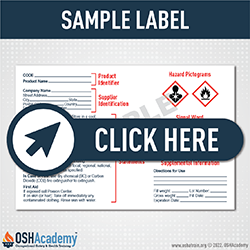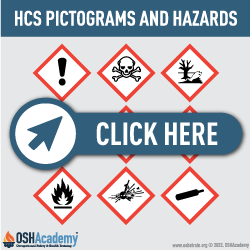Labeling Requirements
Labeling is one of the three-part approaches to communicating information downstream. A label must be on the immediate container of every hazardous chemical. The label is an immediate type of warning since it is present in the work area, right on the actual container of a hazardous chemical. It is a snapshot of the hazards and protective information related to the chemical, and a summary of the more detailed information available on the SDS.
When you purchase a hazardous chemical from a supplier, you will receive a container that is labeled with the information required under the HCS. All shipped container labels are required to have pictograms, a signal word, hazard and precautionary statements, the product identifier, and supplier identification. A sample revised HCS label, identifying the required label elements, is shown to the right. Supplemental information can also be provided on the label as needed.
Required Labeling Elements
Pictograms. A pictogram is a composition that may include a symbol plus other graphic elements, such as a border, background pattern, or color, that is intended to convey specific information about the hazards of a chemical. Eight pictograms are designated under this standard for application to a hazard category.
Signal Words. A signal word is a word used to indicate the relative level of severity of hazard and alert the reader to a potential hazard on the label. The signal words used in the standard are "danger" and "warning." "Danger" is used for the more severe hazards, while "warning" is used for less severe hazards.
Hazard Statement. A hazard statement is a statement assigned to a hazard class and category that describes the nature of the hazard(s) of a chemical, including, where appropriate, the degree of hazard. Example: Fatal if swallowed.
Product Identifier. The product identifier is any chemical, common, or trade name or designation that the chemical manufacturer or importer chooses to use on the label. The term must also appear on the SDS.
Precautionary Statement. A precautionary statement is a phrase that describes recommended measures that should be taken to minimize or prevent adverse effects resulting from exposure to a hazardous chemical, or improper storage or handling. Example: Do not eat, drink, or smoke when using this product.
Some employers use third-party workplace label systems, such as those that have numerical ratings to indicate the hazards (e.g., National Fire Protection Association (NFPA) or Hazardous Materials Identification System (HMIS)). These may be used in conjunction with the supplemental information on the label to ensure that workers have complete information, as long as the ratings are consistent with the hazard definitions in OSHA's Hazard Communication Standard.
Knowledge Check Choose the best answer for the question.
1-8. "Fatal if swallowed" is an example of a _____.
You forgot to answer the question!


